Class of 2025: Blessed and ready for the future
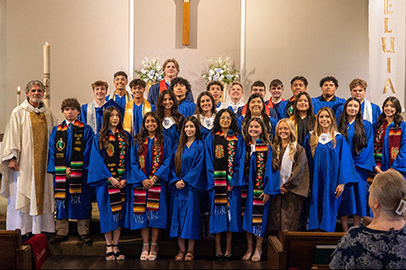

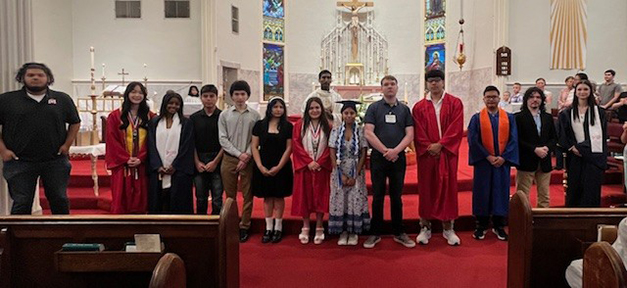


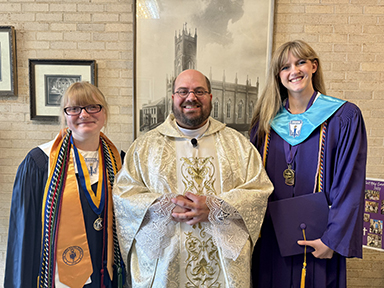
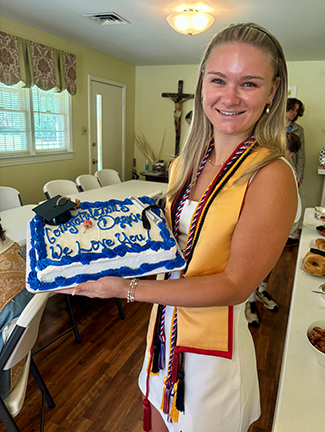
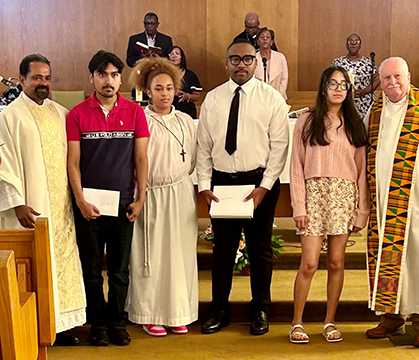
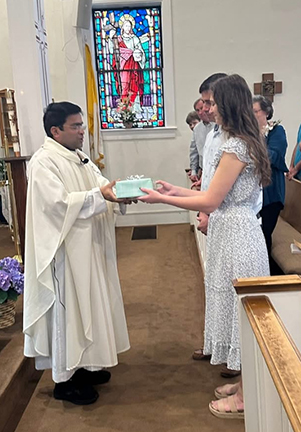









June 13
Junio 13
May 23
Mayo 23
April 25
Abril 25
April 11
Abril 11
March 28
Marzo 28
March 14
marzo 14
February 28
Febrero 28
February 14
Febrero 14
January 31
31 de enero
January 17, 2025
By Cindy Wooden
VATICAN CITY (CNS) – Cardinal Robert F. Prevost, the Chicago-born prefect of the Dicastery for Bishops under Pope Francis, was elected the 267th pope May 8 and took the name Pope Leo XIV.
He is the first North American to be elected pope and, before the conclave, was the U.S. cardinal most mentioned as a potential successor of St. Peter.
The white smoke poured from the chimney on the roof of the Sistine Chapel at 6:07 p.m. Rome time and a few minutes later the bells of St. Peter’s Basilica began to ring.
About 20 minutes later the Vatican police band and two dozen members of the Pontifical Swiss Guard marched into St. Peter’s Square. They soon were joined by the marching band of the Italian Carabinieri, a branch of military police, and by units of the other branches of the Italian military.
As soon as news began to spread, people from all over Rome ran to join the tens of thousands who were already in the square for the smoke watch. Rome Mayor Roberto Gualtieri was among them.
French Cardinal Dominique Mamberti, protodeacon of the College of Cardinals, appeared on the central balcony of St. Peter’s Basilica at 7:12 p.m. He told the crowd: “I announce to you a great joy. We have a pope (‘Habemus papam’),” saying the cardinal’s name in Latin and announcing the name by which he will be called.
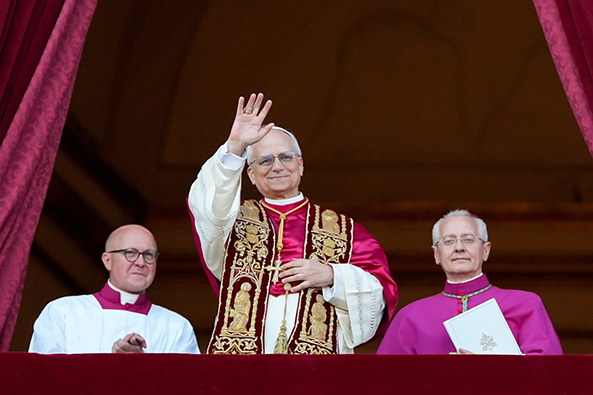
Ten minutes later, the new Pope Leo came out onto the balcony, smiling and waving to the crowd wearing the white papal cassock, a red mozzetta or cape and a red stole to give his first public blessing “urbi et orbi” (to the city and the world).
The crowd shouted repeatedly, “Viva il papa” or “Long live the pope” as Pope Leo’s eyes appeared to tear up.
“Peace be with you,” were Pope Leo’s first words to the crowd.
“My dear brothers and sisters, this is the first greeting of the risen Christ, the good shepherd who gave his life for God’s flock,” he said, praying that Christ’s peace would enter people’s hearts, their families and “the whole earth.”
The peace of the risen Lord, he said, is “a peace that is unarmed and disarming.”
Signaling strong continuity with the papacy of Pope Francis, Pope Leo told the crowd that God “loves all of us unconditionally” and that the church must be open to everyone.
“We are all in God’s hands,” he said, so “without fear, united, hand in hand with God and with each other, let us go forward.”
He thanked the cardinals who elected him, apparently on the fourth ballot of the conclave, “to be the successor of Peter and to walk with you as a united church always seeking peace, justice” and together being missionary disciples of Christ.
Telling the crowd that he was an Augustinian, he quoted St. Augustine, who said, “With you I am a Christian and for you a bishop.”
“Together we must try to be a missionary church, a church that builds bridges and always dialogues, that is always open to receiving everyone like this square with its arms open to everyone, everyone in need,” he said.
The new bishop of Rome told the people of his diocese and of the whole Catholic Church, “We want to be a synodal church, a church that journeys, a church that seeks peace always, that always seeks charity, that wants to be close to people, especially those who are suffering.”
After asking the crowd to recite the Hail Mary with him, Pope Leo gave his first solemn blessing.
Cardinals over the age of 80, who were not eligible to enter the conclave, joined the crowd in the square. Among them were Cardinals Seán P. O’Malley, the retired archbishop of Boston; Donald W. Wuerl, the retired archbishop of Washington; and Marc Ouellet, retired prefect of the Congregation for Bishops.
A longtime missionary in Peru, the 69-year-old pope holds both U.S. and Peruvian citizenship.
La Repubblica, the major Italian daily, described him April 25 as “cosmopolitan and shy,” but also said he was “appreciated by conservatives and progressives. He has global visibility in a conclave in which few (cardinals) know each other.”
That visibility comes from serving as prefect of the Dicastery for Bishops for the past two years, he was instrumental in helping Pope Francis choose bishops for many Latin-rite dioceses, he met hundreds of bishops during their “ad limina” visits to Rome and was called to assist Latin-rite bishops “in all matters concerning the correct and fruitful exercise of the pastoral office entrusted to them.”
The new pope was serving as bishop of Chiclayo, Peru, when Pope Francis called him to the Vatican in January 2023.
During a talk at St. Jude Parish in Chicago in August, the then-cardinal said Pope Francis nominated him “specifically because he did not want someone from the Roman Curia to take on this role. He wanted a missionary; he wanted someone from outside; he wanted someone who would come in with a different perspective.”
In a March 2024 interview with Catholic News Service, he said Pope Francis’ decision in 2022 to name three women as full members of the dicastery, giving them input on the selection of bishops “contributes significantly to the process of discernment in looking for who we hope are the best candidates to serve the church in episcopal ministry.”
To deter attitudes of clericalism among bishops, he said, “it’s important to find men who are truly interested in serving, in preaching the Gospel, not just with eloquent words, but rather with the example and witness they give.”
In fact, the cardinal said, Pope Francis’ “most effective and important” bulwark against clericalism was his being “a pastor who preaches by gesture.”
In an interview in 2023 with Vatican News, then-Cardinal Prevost spoke about the essential leadership quality of a bishop.
“Pope Francis has spoken of four types of closeness: closeness to God, to brother bishops, to priests and to all God’s people,” he said. “One must not give in to the temptation to live isolated, separated in a palace, satisfied with a certain social level or a certain level within the church.”
“And we must not hide behind an idea of authority that no longer makes sense today,” he said. “The authority we have is to serve, to accompany priests, to be pastors and teachers.”
As prefect of the dicastery then-Cardinal Prevost also served as president of the Pontifical Commission for Latin America, where nearly 40% of the world’s Catholics reside.
A Chicago native, he also served as prior general of the Augustinians and spent more than two decades serving in Peru, first as an Augustinian missionary and later as bishop of Chiclayo.
Soon after coming to Rome to head the dicastery, he told Vatican News that bishops have a special mission of promoting the unity of the church.
“The lack of unity is a wound that the church suffers, a very painful one,” he said in May 2023. “Divisions and polemics in the church do not help anything. We bishops … must accelerate this movement toward unity, toward communion in the church.”
In September, a television program in Peru reported on the allegations of three women who said that then-Bishop Prevost failed to act against a priest who sexually abused them as minors. The diocese strongly denied the accusation, pointing out that he personally met with the victims in April 2022, removed the priest from his parish, suspended him from ministry and conducted a local investigation that was then forwarded to the Vatican. The Vatican said there was insufficient evidence to proceed, as did the local prosecutor’s office.
Pope Leo was born Sept. 14, 1955, in Chicago, Illinois. He holds a bachelor’s degree in mathematics from the Augustinian-run Villanova University in Pennsylvania and joined the order in 1977, making his solemn vows in 1981. He holds a degree in theology from the Catholic Theological Union in Chicago and a doctorate from the Pontifical University of St. Thomas Aquinas in Rome.
He joined the Augustinian mission in Peru in 1985 and largely worked in the country until 1999 when he was elected head of the Augustinians’ Chicago-based province. From 2001 to 2013, he served as prior general of the worldwide order. In 2014, Pope Francis named him bishop of Chiclayo, in northern Peru, and the pope asked him also to be apostolic administrator of Callao, Peru, from April 2020 to May 2021.
The new pope speaks English, Spanish, Italian, French, Portuguese and can read Latin and German.
By Cindy Wooden
VATICAN CITY – Pope Francis, who died April 21 at the age of 88, gave new energy to millions of Catholics – and caused concern for some – as he transformed the image of the papacy into a pastoral ministry based on personal encounters and strong convictions about poverty, mission and dialogue.
U.S. Cardinal Kevin J. Farrell, chamberlain of the Holy Roman Church, announced that Pope Francis had died at 7:35 a.m.
“His whole life was dedicated to the service of the Lord and his church,” Cardinal Farrell said in a video announcement broadcast from the chapel of the Domus Sanctae Marthae, where Pope Francis lived.
His gestures – from tenderly embracing the sick to repeatedly visiting prisoners – touched millions of hearts. But controversy raged over his denunciations of the excesses of unbridled capitalism, his warnings about the human contributions to climate change and his insistence on accompanying, not judging, gay people.
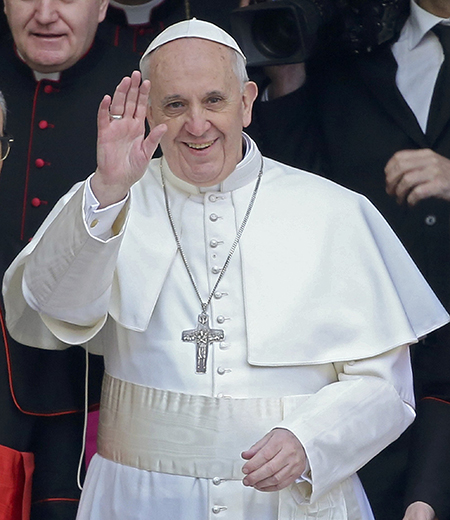
With bronchitis and difficulty breathing, Pope Francis was admitted to Rome’s Gemelli hospital Feb. 14. He was diagnosed with double pneumonia and a complex infection. He had returned to the Vatican March 23 to continue his convalescence.
God’s mercy was a constant theme in Pope Francis’ preaching and was so central to his vision of what the church’s ministry must embody that he proclaimed an extraordinary Holy Year of Mercy for Dec. 8, 2015-Nov. 20, 2016.
Elected March 13, 2013, Pope Francis was the first pope in history to come from the Southern Hemisphere, the first non-European to be elected in almost 1,300 years and the first Jesuit to serve as successor to St. Peter.
In the first three years of his papacy, he published three major documents: “Evangelii Gaudium” (“The Joy of the Gospel”), a detailed vision of the program for his papacy and his vision for the church – particularly the church’s outreach and its response to challenges posed by secular culture; “Laudato Si’, on Care for Our Common Home,” on the environment; and “Amoris Laetitia” (“The Joy of Love”), his reflections on the discussions of the synods of bishops on the family in 2014 and 2015.
Holiness was the topic of his March 2018 apostolic exhortation, “Gaudete et Exsultate” (“Rejoice and Be Glad”) in which he insisted being holy is not boring or impossible, and that it grows through small, daily gestures and acts of loving kindness.
Following in the footsteps of his predecessors, Pope Francis was an untiring voice for peace, urging an end to armed conflict, supporting dialogue and encouraging reconciliation. The pope described Russia’s invasion of Ukraine as “madness” and called on the world’s bishops to join him in consecrating Ukraine and Russia to the Immaculate Heart of Mary. When Hamas militants attacked communities in Israel, killing scores of people and taking more than 200 people hostage in late 2023, and Israel retaliated by attacking Gaza, Pope Francis made repeated appeals for the return of hostages, a ceasefire to deliver humanitarian aid, and a real commitment to a negotiated peace.
Promoting peace, solidarity and respect for the Earth, the pope insisted people needed to recognize each other as brothers and sisters and issued an encyclical about that, “Fratelli Tutti, on Fraternity and Social Friendship.” He signed the text at the tomb of St. Francis of Assisi on the saint’s feast day, Oct. 4, 2020.
Pope Francis spent much of the first nine years of his pontificate pursuing two ambitious projects: revitalizing the church’s efforts at evangelization – constantly urging outreach rather than a preoccupation with internal church affairs – and reforming the central administration of the Vatican, emphasizing its role of assisting bishops around the world rather than dictating policy to them.
On March 19, 2022, the ninth anniversary of the inauguration of his papacy, he finally promulgated “Praedicate Evangelium” (“Preach the Gospel”), his complete restructuring of the Roma Curia, highlighting its mission to serve the church’s evangelization efforts at all levels.
His simple lifestyle, which included his decision not to live in the Apostolic Palace and his choice of riding around Rome in a small Fiat or Ford instead of a Mercedes sedan, sent a message of austerity to Vatican officials and clergy throughout the church. He reinforced the message with frequent admonitions about the Gospel demands and evangelical witness of poverty and simplicity.
Although he repeatedly said he did not like to travel, he made 47 foreign trips, taking his message of Gospel joy to North and South America, Europe, Africa and Asia.
Jorge Mario Bergoglio was born in Buenos Aires, Argentina’s capital city, Dec. 17, 1936. He earned a chemical technician’s diploma from his high school and entered the Jesuit novitiate in March 1958. After studying liberal arts in Santiago, Chile, he returned to Argentina and earned his licentiate in philosophy from the Colegio San Jose in San Miguel.
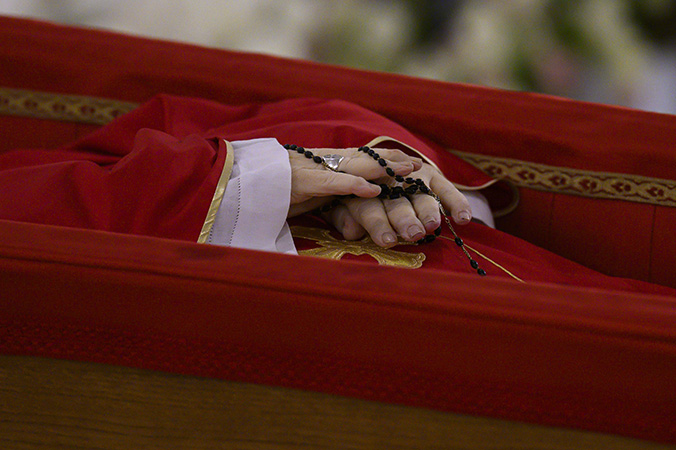
He was ordained a priest Dec. 13, 1969, and after his perpetual profession as a Jesuit in 1973, he became master of novices at the Seminary of Villa Barilari in San Miguel. Later that same year, he was appointed superior of the Jesuit province of Argentina, a role in which by his own account he proved a divisive figure because of an “authoritarian and quick manner of making decisions.”
In May 1992, Father Bergoglio was named an auxiliary bishop of the Archdiocese of Buenos Aires. He was appointed coadjutor archbishop five years later and became archbishop of Buenos Aires in 1998; Pope John Paul II named him to the College of Cardinals in 2001.
As leader of an archdiocese with more than 2.5 million Catholics, Cardinal Bergoglio strove to be close to the people. He rode the bus, visited the poor, lived in a simple apartment and cooked his own meals.
His international reputation was enhanced by his work at the 2007 assembly of the Latin American bishops’ council, CELAM, and particularly by his role as head of the committee that drafted the gathering’s final document on reforming and reinvigorating the church’s evangelizing efforts on the continent.
Cardinal Bergoglio was a known and respected figure within the College of Cardinals, so much so that no one disputed a respected Italian journal’s report that he received the second-highest number of votes on all four ballots cast in the 2005 conclave that elected Pope Benedict XVI.
Eight years later, Pope Benedict retired. At the cardinals’ meetings prior to the 2013 conclave to elect his successor, the need to reform the Vatican bureaucracy was a common theme of concern.
Addressing the gathering, Cardinal Bergoglio warned against “self-referentiality and a kind of theological narcissism” in the church and argued the next pope “must be a man who, from the contemplation and adoration of Jesus Christ, helps the church to go out to the existential peripheries” to spread the Gospel.
His election March 13 came on the second day of the conclave, on its fifth ballot. He chose the name Francis to honor St. Francis of Assisi, “the man of poverty, the man of peace, the man who loves and protects creation,” he said.
“Go out” was Pope Francis’ constant plea to every Catholic, from curial cardinals to the people in the pews. More than once, he told people that while the Bible presents Jesus as knocking at the door of people’s hearts to get in, today Jesus is knocking at the doors of parish churches trying to get out and among the people.
But he faced criticism for what many saw as a lack of consistency in dealing forcefully with the clerical sexual abuse crisis, especially when it came to holding bishops accountable for handling allegations and removing priests credibly accused of abuse.
And while his pontificate marked major progress in the Vatican’s attempts to reach an agreement with China’s communist government on the appointment of Catholic bishops, a provisional accord signed in September 2018, and renewed in 2020, 2022 and 2024, was denounced by critics as a betrayal of Catholics who risked their lives for refusing any cooperation with the communists.
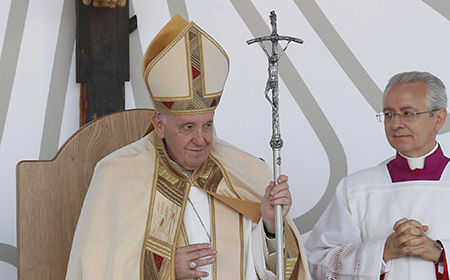
Like his predecessors, Pope Francis was a strong defender of the sacredness of human life. Meeting Catholic physicians in November 2014, for example, he insisted that in “the light of faith and the light of correct reason, human life is always sacred and always of ‘quality.’ There is no human life that is more sacred than another” and no “human life qualitatively more significant than another.”
For Pope Francis, helping the defenseless also meant paying special attention to prisoners, victims of war and, particularly, Christians and other religious minorities persecuted for their faith.
When Islamic State forces and other terrorist groups began specifically targeting Christians and other religious minorities in Syria and Iraq, and later in North Africa, Pope Francis demanded the international community act.
He frequently cited figures that the number of Christian martyrs is greater today than in the first centuries of Christianity, and he insisted the international community cannot “look the other way.”
Editor’s note: On Wednesday April 9, diocesan schools in the metro Jackson area received on-site visits from Cognia Accreditation. Accreditation by Cognia ensures that a school meets rigorous educational standards and is committed to continuous improvement, providing credibility and quality assurance for students, parents and educators.


MADISON – (Top) Dr. Michael Bratcher of Cognia observes Patricia Holder’s classroom at St. Anthony School. (Right) Thomas Caskey chats with Dr. Bratcher about how much he loves St. Anthony School. (Photos by Joanna Puddister King)
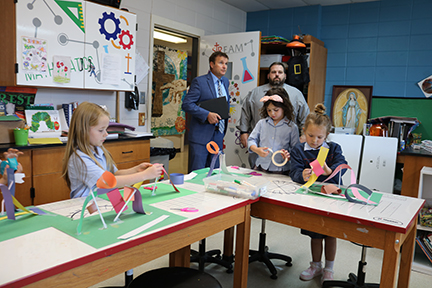
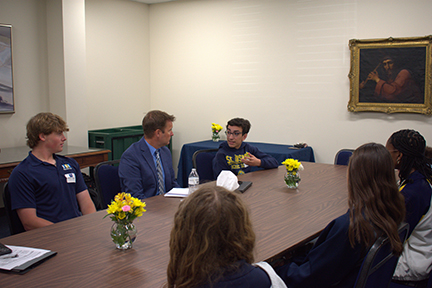
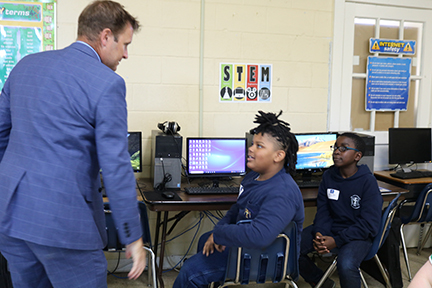

JACKSON – (Above) Sister Thea Bowman School fifth grade students, Khamari Stevenson and Harry Chia greet Dr. Michael Bratcher before they took him on an informative tour of the school. (Right) All students pointed to the state of Kentucky where Dr. Bratcher is from. (Photos by Tereza Ma)

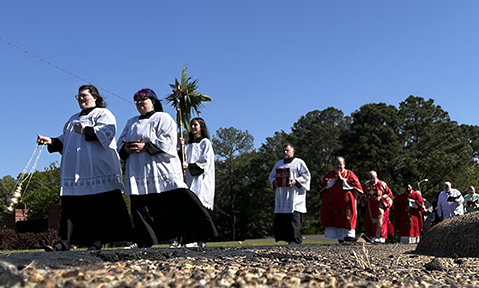
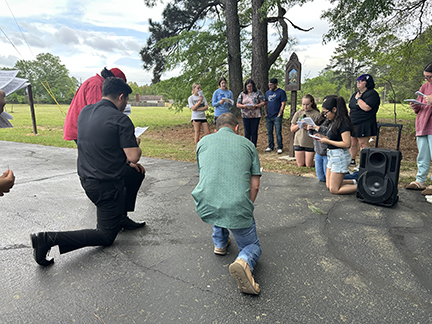
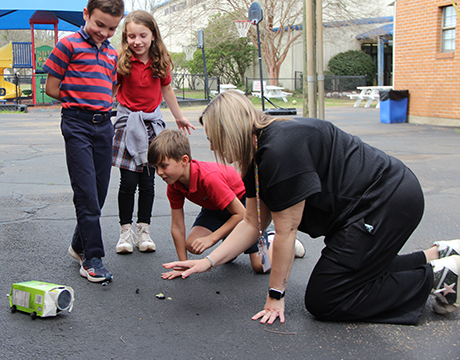





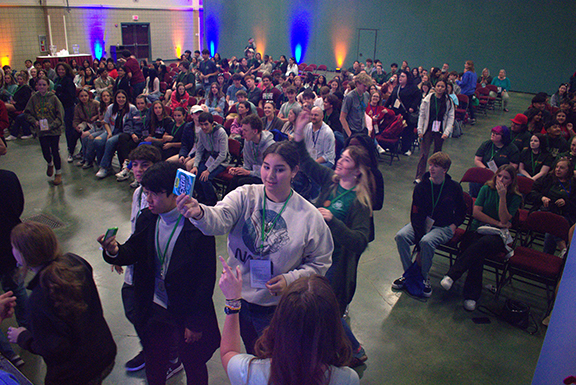
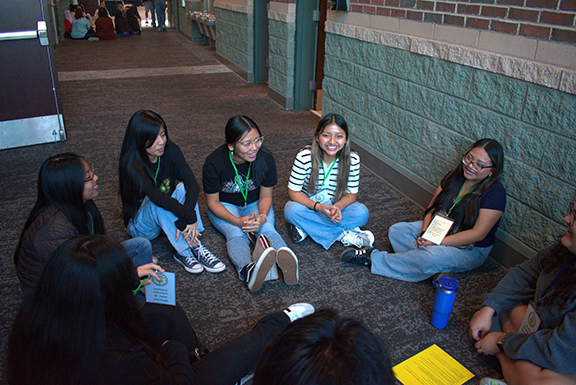
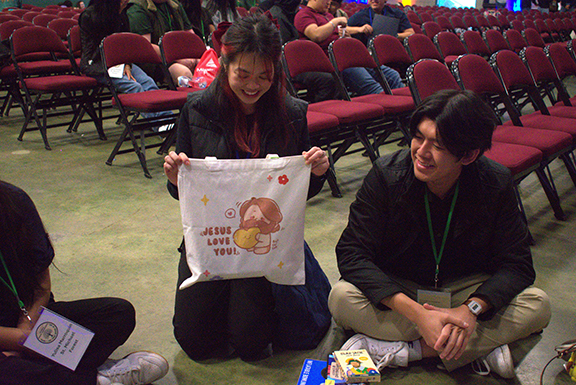
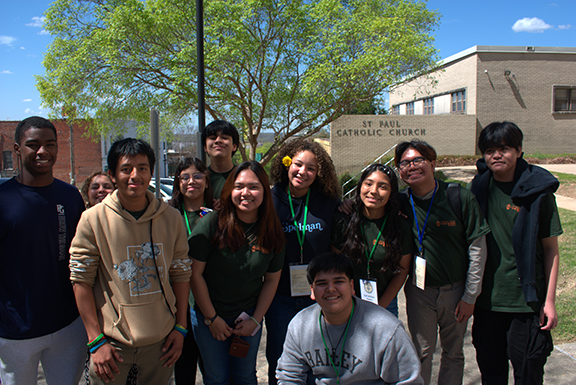


By Mary Woodward
JACKSON – As the green haze of spring pollen fills the air coating our cars, sidewalks, and nasal passages, another reality of warmer weather emerges – mosquitoes. These disease-carrying flying monsters have wreaked havoc on the human population for centuries.
In the mid and late 1800s, Yellow Fever was the epidemic feared by the population in our diocese and around the warmer, humid climate zones. Clergy, religious and laity were all fair game for infection and entire towns would quarantine. It was survivable, but thousands did not survive. Our second bishop, James Oliver Van de Velde, died of Yellow Fever in 1855.
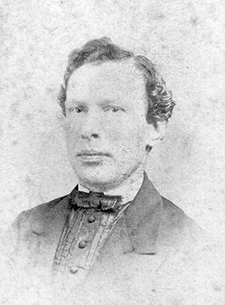
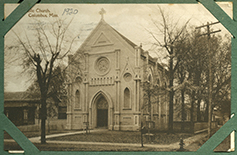
Rev. Jean Baptiste Mouton, who died of Yellow Fever along with five other priests in 1878. Father Mouton was an architect who designed several churches in the mid 1800 including Annunciation Catholic Church in Columbus. (Photo courtesy of Mary Woodward)
Bishop William Henry Elder, our third bishop, contracted the fever but survived it. However, Bishop Elder lost six of his priests to the fever’s outbreak in 1878. From August 31 – September 14, 1878, the then Diocese of Natchez lost: Fathers Jean Baptiste Mouton (8/31), Patrick Cogan (9/8), John McManus (9/8), Anacletus Oberti (9/11), Charles Van Queckleberge (9/11) and John Vitolo (9/14).
In a letter from November 1878, Father Patrick Hayden writes Bishop Elder from Columbus lamenting the loss of the six men, especially Father Mouton, who was a trained architect and had designed several of the churches in the eastern half of the diocese, including the original church in Columbus.
Father Cogan was in Canton and was said to be the only remaining minister in the town when the outbreak occurred. An interesting note from a newspaper article reveals ministers of other denominations wanted to stay but were convinced to leave because they had wives and children, who would be left destitute without them if they died. There is a monument for Father Cogan at Sacred Heart in Canton.
We must remember, though, that alongside these priests were fearless women religious – Sisters of Mercy and Sisters of Charity – Angels, who served as nurses to the sick and eventually themselves died. Rarely are these heroic women given names, but in the case of Holly Springs St. Joseph, we do have at least the first names of the six Sisters of Charity who died – Stanislaus, Stella, Margaret, Victoria, Lorentia and Corinthia.
Cleta Ellington in her masterwork “Christ the Living Water,” written for the Diocese of Jackson’s 150th anniversary in 1988, gives a stirring account of the epidemic of 1878 in Holly Springs. It follows below along with the tribute given to Sr. Corinthia Mahoney by an eyewitness account.
“In the late summer and early fall of 1878, yellow fever swept across Mississippi like a conquering army, but it appeared that Holly Springs was to be spared. The city fathers, in a burst of generosity and believing that the germ could not live in such a high and dry climate, opened the doors of the town to feverish refugees from surrounding counties.”
Two articles from New Orleans newspapers reveal the swiftness with which the townspeople learned their leadership was in error.
“August 13, 1878: ‘The town is clean and healthy…no symptoms of the outbreak here. We have thrown open our hospitality to our sister cities, even accepting Grenada where the fever rages. The mayor and the community council decided today to use disinfectants merely as a precautionary…’
“August 19, 1878: ‘Yesterday there were seven deaths, last night six, five of whom died in our house. The situation is too appalling to be described and the worst is, not a single case has recovered or promises recovery.’
The Marshall County Courthouse was turned into a hospital where beds were piles of straw, where black and white lay together to await medical treatment almost certainly useless. The 12 sisters at Bethlehem Academy closed the school and took over the courthouse hospital. They were joined by a number of volunteer doctors who had heroically rushed to the town and by Father Anacletus Oberti, a friendly Italian priest, 31 years old, who had been working very hard to establish a Catholic library at St. Joseph. Six of the sisters, all of them part of the original group at Holly Springs, died during September and October. Father Oberti died on Sept. 11. Over 300 of the townspeople perished, 30 of them Catholic.
Dr. R.M. Swearingen, a volunteer from Austin, Texas, penciled a tribute to Sister Corinthia Mahoney on the plaster wall of a jury room. It remained there until 1925 when the courthouse was renovated. To save the tribute, R.A. McDermott had workmen remove that section of the wall. Then he took it to Nazareth, Ky., where it remained until 1971 when it was returned to Holly Springs to the Marshall County Historical Museum where it can be seen today.
Within this room, September 1878, Sister Corinthia sank into eternal sleep. Among the first to enter this realm of death, she was the last, save one, to leave. The writer of this humble notice saw her in health, gentle but strong, as she moved with noiseless steps and serene smiles through the crowded wards. He saw her when the yellow plumed angel threw his golden shadows over the last sad scene, and eyes unused to weeping paid the tribute of tears to the brave and beautiful “Spirit of Mercy.”
Father Oberti and the sisters were laid to rest in the local cemetery where a monument was erected by a grateful town. And Bethlehem Academy reopened its doors.
Be safe and remember to take all precautions against mosquito bites this year. Sr. Corinthia is watching and praying for us.
(Mary Woodward is Chancellor and Archivist for the Diocese of Jackson.)




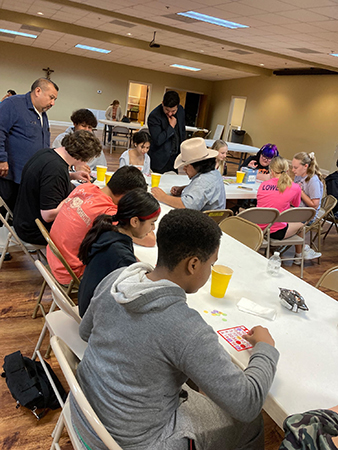


VICKSBURG – (left) 1st and 2nd graders performed their music program, Sing a Song of Folklore. (Photo by Hannah Hinson.
(above) Our 100+ member cast performed 6 sold-out showings of Disney’s The Little Mermaid as our spring musical. (Photo by Anna Griffing)
